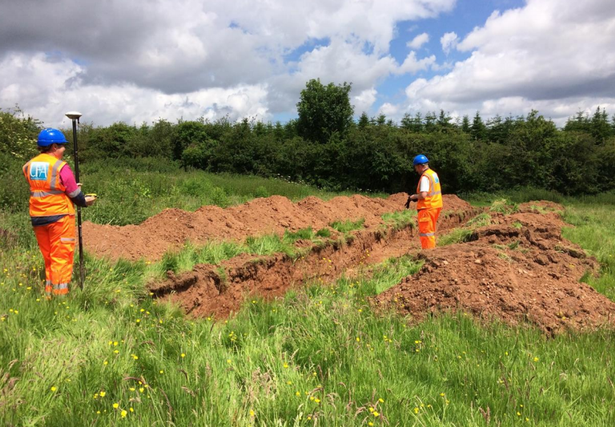HS2 could uncover ancient treasures buried hundreds of years ago

From Anglo-Saxon remains to Roman relics, HS2 works are shining a light on the Midlands’ long-lost past. The Local Democracy Reporting Service looks at one of the often overlooked aspects of Britain’s biggest civil engineering project.
What lies beneath?
That’s the question that many history buffs will be asking as the ground around the region is opened up as part of preparations for the HS2 rail project.
Thousands of trial trenches have already been dug along the length of the line, as part of the archaeological work which comes ahead of construction starting in earnest.
HS2 bosses argue the excavations offer an unprecedented chance to delve into the rich history of sites and uncover relics from hundreds if not thousands of years ago.
Although some of the scheme’s critics are worried that works will scythe through sites which remain undiscovered, destroying irreplaceable artefacts.
#Solihull is among the areas where archaeologists have already been on-site this year, scraping back the soil to see what they can unearth.
These investigations have been mixed in with rather more mundane work, such as drilling boreholes and clearing hedgerows, and have probably gone unnoticed by many local residents.
There’s also the fact that, as we reported last month, the experts don’t broadcast where they’re digging trenches for fear that the sites may be targeted by so-called nighthawks.
These rogue metal detectorists are known to steal onto land under cover of darkness and make off with valuable items.
Despite a degree of secrecy about the exact location of trenches, Tony Hanna, HS2’s historic environment manager, had last month briefed borough councillors on the work more generally.
“[We will create] a lasting legacy for other archaeologists, historians, academics, researchers and anyone else who is interested in history,” he said.
“It’s the largest archaeological excavation that has ever been undertaken in Europe, never mind the UK.”
HS2 has been poring through ancient documents, creating high-resolution maps and examining aerial photographs to “pinpoint” possible areas of interest.
The next stage of the evaluation process, which the team is about three quarters of the way through, involves digging the “trial trenches”.
“At present we have excavated over 3,000 trenches,” said Mr Hanna.
“Each trench is 15 metres long by two metres wide and I think that’s a considerable amount of work in such a short time.”
Area north – which encompasses the Midlands – covers around 50km and more than 100 archaeological sites.
Among the areas of interest in Solihull include Iron Age remnants near Bickenhill, agricultural enclosures in Balsall Common which date from the Roman era and a possible Medieval moated site at Chelmsley Wood.
Over the border in Warwickshire, a site dating from the reign of Elizabeth II is being looked at in Coleshil and there is a lot of interest around a possible Anglo-Saxon cemetery in the county.
The second site – which is well over 1,000-years-old – has been described as “particularly exciting” because of the rarity of these burial grounds in this part of the world.
Following the initial evaluations, Mr Hanna said that there would be around 20 “large-scale archaeological excavations” taking place in the region through until 2021.
If a particularly significant site, the example of a Roman villa has been given, was found to lie in the way of the route then it would be flagged up with the Secretary of State.
Discussions would then follow about the possible options to preserve the find.
Despite various assurances, Balsall Common resident Richard Lloyd remains worried that workmen could unwittingly plough through areas of real significance and wanted a “100 per cent” guarantee that unrecognised sites weren’t at risk.
“This is all enormously exciting stuff but my concern remains that we’ve seen enormous areas of disturbance [in] areas north and south of Balsall Common.
“What I want to see is a map showing that those areas have been properly surveyed by geophysical means or otherwise to make sure that there was nothing there.
“And until I see a map I’m not going to be satisfied.”
HS2 insisted it had built-up a detailed picture of the local area, but reiterated that some of the details were too “sensitive” to make public at this stage.
Questions have also inevitably been asked about what will happen to the items which the work turns up.
Many residents will remember the fight, almost a decade ago, to ensure that a 7th century hoard uncovered in Staffordshire remained in the region.
Kingshurst & Fordbridge councillor David Cole (Lab), a self-described history buff, said: “I hope that these finds will stop in the West Midlands and not cascade down to London if they have somebody interested.”
HS2 has said discussions are already going on about what would happen to “the multitude” of items which are collected and that support would be available to local facilities, including the option to bid for funding.
In Solihull there may be some debate about the most suitable venue to display discoveries.
There is no council-owned museum, although the heritage and local studies service does hold a number of historic items.
The community-run Berkswell Museum would once have been the obvious choice for any finds from those surrounding rural areas, but the venue closed its doors in 2016.
Cllr Diane Howell (Con, Meriden) has emphasised the importance of involving residents.
In an appeal to HS2, she said: “Please tell us more about it, tell the community more about it, because people don’t actually know what you’re doing.”
Mr Hanna said that his team was keen to engage with local people to help “fill in the gaps” around what is pulled out of the soil.
The work includes taking a “time truck” out to local communities to discuss finds and draw on local knowledge.
“We want everyone to tell their story, the story of their area, their heritage, their own knowledge, to help us – as archaeologists – to understand a bit more about the landscape we are examining,” he said.
“Archaeology is about storytelling. The story of communities, people and culture which went before us.”
Read more: https://www.birminghammail.co.uk/news/midlands-news/hs2-could-uncover-ancient-treasures-16781023

